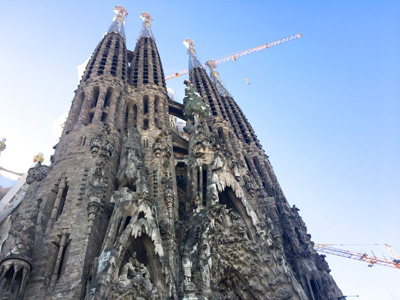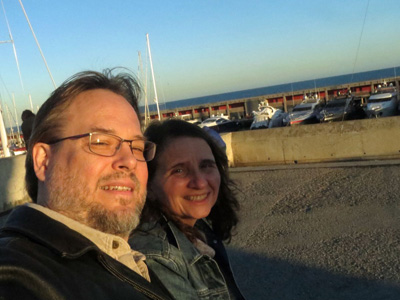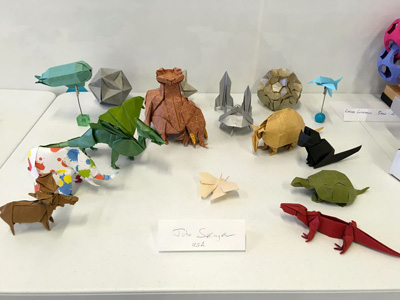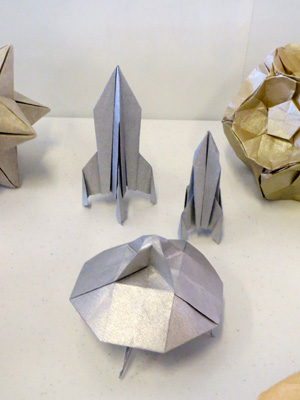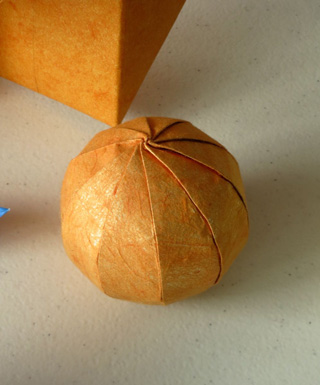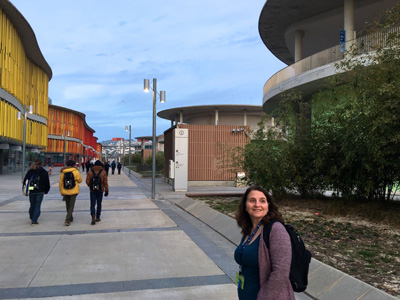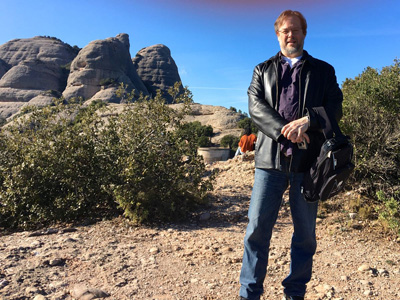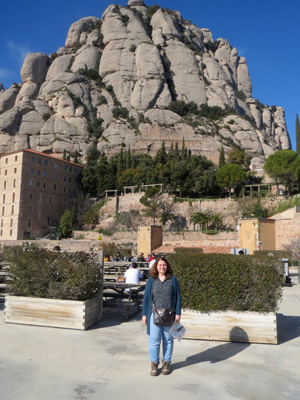Now we get to the trip inside the trip, like a tunnel that you follow to a tunnel of its own. We arrived in Zaragoza late Friday night. The train station was sparsely peopled, and we wandered down, thru the concourse, up the other side to exit on the correct side. From there is was was a long pedestrian bridge arcing above a wide highway, whose reticulated walking surface made our luggage rattle out a rhythm as it rolled along. It was colder and windier here than by the seaside, very bracing. Zaragoza is in the desert and the mountains, although often strongly foggy.
The hotel was one building past the conference center. The whole neighborhood was built for some kind of Expo about twelve years ago, and it had that kind of vibe, all modernist right angles. The hotel was nice, stark yet cozy, modern and European. There were some friendly faces in the lobby, our the conference organizers and our hosts. I knew a few of them who had been to origami conventions in the states, and everyone was warm and friendly.
Next day up bright and early for breakfast. I met a few fellow folders including Robert Lang, David Brill and Jared Needle and Matt Green. More bacon and eggs and croissants and cappuccinos. Yum!
Over at the conference center I set up my exhibit. This was first international exhibit, most of ’em here had never seen my work before. I brought a box a small suitcase as carry-on luggage, about fifteen models. The idea was sort of a greatest hits collection.
The evening before our flight to Spain I went around the house and picked out my favorite models and set them on the table to see how they went together. There’s some air and space ships, a set of single-sheet polyhedra, a series of big animals and one of small animals. The big animals include my Elephant and Dragon, but they were a bit too small for the others in that series, the Oliphaunt and Moose.
So I started folding a new one of each. I ended spending most of the next day folding Dragons and Elephants, and my exhibit was the last thing I packed, just before leaving for the airport. It was totally worth it, both models turned out great. For the Elephant i found a 12″ square of scrapbook paper, mainly white with bright paint splatter design, evoking a circus. I didn’t know how well the paper would fold but it ended up being perfect for the model, not too thin, not too thick, not too soft and not too stiff. It came out quite well, nicely sculptured, and was one of my most admired models in the exhibit.
For the dragon I used so-called shiny paper from the Origami Shop, which is an excellent paper, thin an crisp, and sort of sparkly on one side. I started folding a blue dragon from a 16″ square, but once I got the base finished it was clear it would not be bit enough. I went up to a 24″ green square. Probably a 20″ square would have been perfect, but I didn’t have one. Still it worked well at that size, and was compatible with the Oliphaunt, just a slightly more ancient dragon than I had in mind.
Once my stuff was set up I took a look around. There was tons of fantastic stuff there. The exhibit space was nice, bright and well-lit, and got a good amount of traffic over the weekend, not just from the convention but from the public at large.
I knew about half the artists there. There was so much great origami, and (unlike OUSA where I see many of the same people every year) alot of it was new to me. It’s impossible to try and describe it all, you’ll have to wait for the pictures. One thing I’ll say is there was alot of interesting stuff with tessellations. I had kinda thought tessellations were pretty much played out, but here was alot of new, expressive work. One artist named Roman particularly caught my eye with a 2-d interpretation of a 4-d Torus. Wow.
The conference opened with remarks by Ilan, the conference chair. The organizers were mostly French, Spanish and Israeli. The format was much like a Monday at OUSA, with seminars and discussion, no teaching models and not alot of actual folding. Everybody there was a world-class origami artist because CFC2, a.k.a The Conference for Creators, was invitation only. It was an honor to have been invited, and It was really amazing to be among such high-level artists. I missed the first CFC, in Lyon, France in the summer of 2017 because I was ill. So making it to this one was extra special for me.
The topics included aspects of the creative process, hand vs. computer diagraming, photography and photo diagramming, spontaneous public origami exhibits, preparing papers for exhibiting, traditional handmade papers, how to social media, and connections between origami and other creative disciplines. There were also several roundtable discussions. Very inspirational.
The pacing was pretty leisurely. There was breakfast, a couple talks, coffee break, another talk or two, another break, more talks, then dinner and/or evening activities. It stretched out so dinner wasn’t until 8 or 9 o’clock. This left lots of time for socializing and hanging out. The attendees included Spaniards, French, Americans, Brits, Germans, a couple from Poland and another from Austria, a few Italians, a few Israelis, a friendly guy from Denmark, and another sharp friendly guy and from Belarus whose English was so good at first I thought he was Scottish, a lady from Switzerland, and several people from South America. Maybe seventy or eighty people total.
I re-struck relationships with people I hadn’t seen in years and made some new friends. I was happy to discover alot of people were familiar with my work and hold it in high regard. Some cited my models as points of inspiration or reference for their own work. That’s a huge compliment from artists you admire.
The French people were telling us to come the French convention next year, the Spanish said to come to the Spanish convention, and the Germans said to come to the German one. This last one sounds pretty tempting cuz it’s one of the larger conventions in Europe, and I seemed to hit it off comfortably with the Germans and Austrians. But everyone said: you gotta go to the Italian convention, it’s a great time and a huge party.
Zaragoza has a very active folding community and many of them are connected with IMOZ (Escuela Museo Origami Zaragoza), the world’s largest permanent museum for origami. Spain has it’s own origami tradition independent of Japan’s, dating back to the 7th century when paper was introduced to the Iberian Peninsula by the Moors. We took a tour there the first evening. It’s quite impressive and includes quite a few works by Yoshizawa and Erik Joisel, and a variety of other stuff, historical and modern, Spanish and international.
We walked around the old downtown for a while, to eventually arrive a restaurant for the convention banquet, which was mainly standing like a cocktail hour, as were the lunches, to promote mingling. The other nights’ dinner was at the hotel, and seated. One night Jeannie and I sat a table full of Germans and Austrians, the other was Spaniards and an Argentinean. More socializing, ham, seafood and fine red wine.
Sunday was the last day of the conference and in the evening, after the official end, were more tourist activities. We went to a place called the Tower of Water, built for the Expo. It was a funny building, a glass and scaffold skyscraper maybe twenty stories high, enclosing a large interior space in which hung a giant sculpture of a splashing water droplet frozen in time. We took an elevator up then spiraled around a continuously ramping balcony back to the lobby. The building had no current use, but at working electricity. One of our hosts had a key to get in.
We wandered thru the Expo grounds, which was broad pedestrian avenues, curvy concrete bridges, and the aforementioned cubist buildings. Parts of the complex, like the conference center (the Etopia Center for Arts and Technology) and the hotel were in active use. Some of the buildings seemed to be offices or apartments. But alot of it was just empty. Not run down or abandoned, just unused. Kinda reminded me of planet Miranda in the movie Serenity, but, you know, not all creepifying. Apparently there was a plan to convert the buildings to other purposes after the Expo, but then the housing bust happened and the money vanished. We ended up at the Aquarium, which was pretty cool. The focus was on the major rivers of the world, so they had alot of fish and reptiles that you don’t normally see.
Bit by bit, over the course of the weekend, people started to get out packs of paper and do some actual folding. I’ve been working on a Human Figure base, derived from my Astronaut, since my nephew Matthew asked me at Christmastime if I could design a Golem. So I folded lots and lots of variations, looking for expressive possibilities, and for different way to approach the neck and shoulders, which is the key to any animal model, human figures included.
Finally Sunday night was the inevitable late-night folding. A bunch of us, under the direction of one of the EMOZ curators, folded a giant corrugation, about three meters square. We didn’t get much sleep that night, but still got up before sunrise to take the train back to Barcelona and on to Montserrat.
There’s lots more happening in the origami world these days, but that will have to wait for another post.
